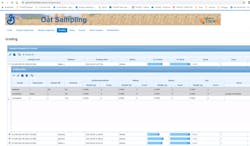Sustainability across the supply chain: Good for business and the environment
One key element of industrial sustainability is to look upstream and downstream of the business along the full supply chain. Materials are an integral element of any manufacturing production operation, and optimizing the transport, storage and delivery of materials can inspire foundational operational changes. This case study looks at how a giant of the grain industry changed its market and processes for the better by using technology to track raw materials to end product. These process changes reduced nearly 20% of vehicle miles covered delivering materials and vastly improved plant efficiency, achieving $40 million in operational savings over 24 months.
General Mills ups its gluten-free game
To support the industrial grain market, a complex supply chain delivers the wheat, barley, oats and other grains that make up breakfast cereals, baked goods and many other grain products. General Mills facilities process about a third of all the oats grown in North America, and more than 60% of those oats go through one General Mills cleaning house in Fridley, MN.
“This is the lynch pin of our work with General Mills' gluten-free oats,” says Doug Lawson, CEO of ThinkIQ, which considers itself part automation player, part IoT platform, part supply chain management system. The technology operates at the supply chain level with materials—farm to fork, mine to metal or rump to stump, depending on the industry.
Process automation is not enough alone to optimize all along the manufacturing value chain, from raw materials to storage, transportation, plant, distribution and finally to consumers (see Figure 1). Often data from each step is siloed (between procurement, manufacturing or quality control), and issues upstream of the supply chain can significantly impact production. ThinkIQ uses machine vision to collect measurements and equipment data, which is accessible through web browsers and stored in a secured cloud server. That data is key to optimizing the supply chain, and for General Mills, it led to major process changes.
In 2016, General Mills began working with ThinkIQ to examine opportunities to improve its grain supply chain and materials delivery processes. End-to-end real-time material movement tracking significantly changed the General Mills’ grain blending process, not only ensuring gluten-free products remained free of gluten, but also significantly improved operations with better yield, throughput, and quality (see Figure 2).
Right oats, right place, right time
Previously, in order to make a gluten-free oat flour, a processing facility would blend as much as possible grain to get a repeatable white flour product at the end of the process. However, this large-scale blending process requires enormous amounts of energy, as well as the resources moving grain on-site and transporting off-site.
“The purpose of the blending is, first and foremost, to combine high-gluten grain with low-gluten grain in order to make more grain that is below the threshold for gluten-free oats. We changed this paradigm by providing clarity into the true gluten levels for all grain in the network and giving optimized blending strategies,” Lawson says (see Figure 3).
Now, by optimizing material delivery, processing facilities can focus on specialty flours (such as gluten-free, high protein or high beta glucan) without waste, rather than blend in large quantities for consistency.
“The industry is now operating in an entirely different way as a result of the work that we did,” says Lawson. “They buy specific oats from specific farmers for specific goals,” which include sustainability goals. In the case of General Mills, the company reduced its number of blends by 90% and reduced the energy wasted taking regular oats and cleaning them (a process that involved removing the barley, wheat, hemp and rice seeds from oats in order to make them gluten-free). Processing specialty grains for a purpose removes extra steps, but it also requires intense coordination.
General Mills also reduced nearly 20% of its vehicle miles covered by optimizing grain delivery. “We’ve gotten to the point without any physical changes to the plant, that the plant runs at about 93% efficiency. When we engaged with them, it was running at 40% efficiency, simply because we’re moving the right oats to the right place at the right time,” Lawson says.
Materials ledger in the cloud: from raw materials to final product
“The importance of cloud computing is vital for supply chains,” Lawson says. “If you think about a physical supply chain, raw materials start at one end of the supply chain; there’s a bunch of intermediate goods that occur; and eventually you make a finished product.”
Except for the most vertically integrated companies, most businesses transcend multiple enterprises in this process from beginning to end. Cloud becomes vitally important to reach across systems and processes and “have the free movement of data between the systems,” Lawson says.
Tracking the movement of materials across the whole supply chain with a materials ledger is vital for this type of improvement (see Figure 4). ThinkIQ technology does this through the use of cloud platforms, vision systems, and artificial intelligence and machine learning. The ThinkIQ system essentially uses machine vision or cameras as generic horizontal sensors. “We use cameras to look at people, to look at trucks, to look and old and instrumented equipment and tell you what’s happening on those people and things and materials,” Lawson says. “All of that is very heavily dependent upon machine learning and AI and models to look at that data. We very seldom talk about ourselves as an ML/AI platform, but it drives an awful lot of what we do.”
All along the industrial supply chain
ThinkIQ has worked in food and beverage, pharmaceutical, automotive, and heavy materials, such as cement, gravel, sand and asphalt.
“We shift the focus to being able to look at the movement of materials through the supply chain and through the factory floor,” Lawson says. “We do that partially for the purpose of traceability, but we’re not a traceability solution. We look at it from the perspective of knowing how things that occur early in a physical process affect things that occur later.”
“We’re carrying the attributes of materials,” Lawson said. For example, an automotive plant receives large rolls of steel, which have measurable attributes, such as surface characteristics, hardness, ductility, cleanliness, or amount of lubricant, among others. With this attribute data, analysis can not only determine how hard or how shiny that roll of cold steel is, but also how much energy has gone into the process step by step.
“You also want to be able to say what is your carbon footprint? In other words, what was the quality of the energy that was used to make a product, and you want to be able to break that down further, which is to say, how much of that was electrical, how much of that was because of how product was transported,” Lawson says. “Everything that moves in a physical supply chain carries its carbon footprint with it, and that’s transformative.”
Sustainability is about energy, Lawson says. This means carbon footprint, but also things like food security, intelligent use of resources, and pollution are important, he adds. “There are an awful lot of things that happen in an industrial supply chain,” Lawson says. “Digital transformation begins with that voyage of saying I need to be able to start quickly. It shouldn’t require massive effort from my IT organization.”
About the Author

Anna Townshend
managing editor
Anna Townshend has been a journalist and editor for almost 20 years. She joined Control Design and Plant Services as managing editor in June 2020. Previously, for more than 10 years, she was the editor of Marina Dock Age and International Dredging Review. In addition to writing and editing thousands of articles in her career, she has been an active speaker on industry panels and presentations, as well as host for the Tool Belt and Control Intelligence podcasts. Email her at [email protected].




